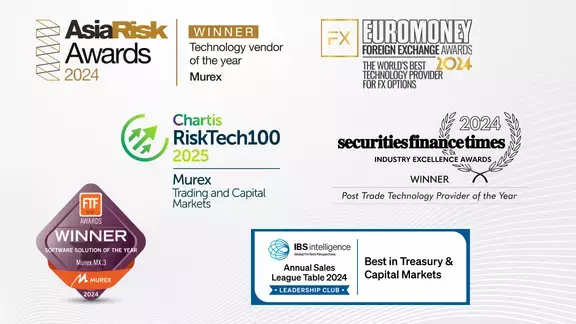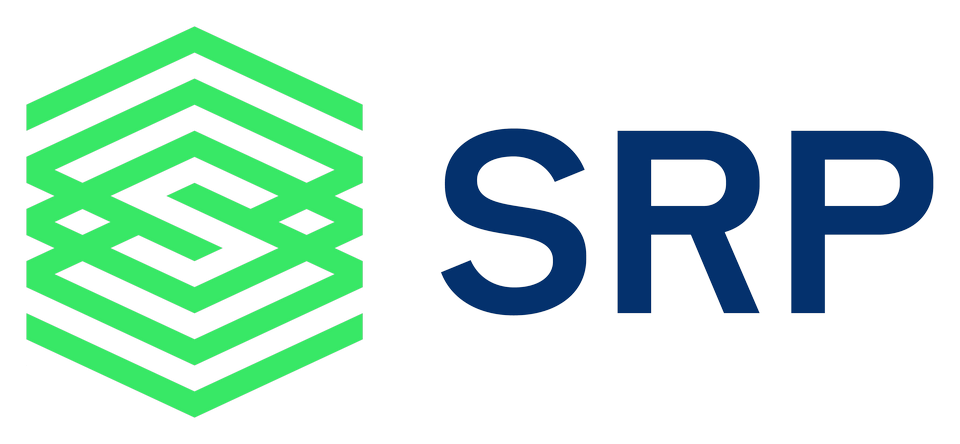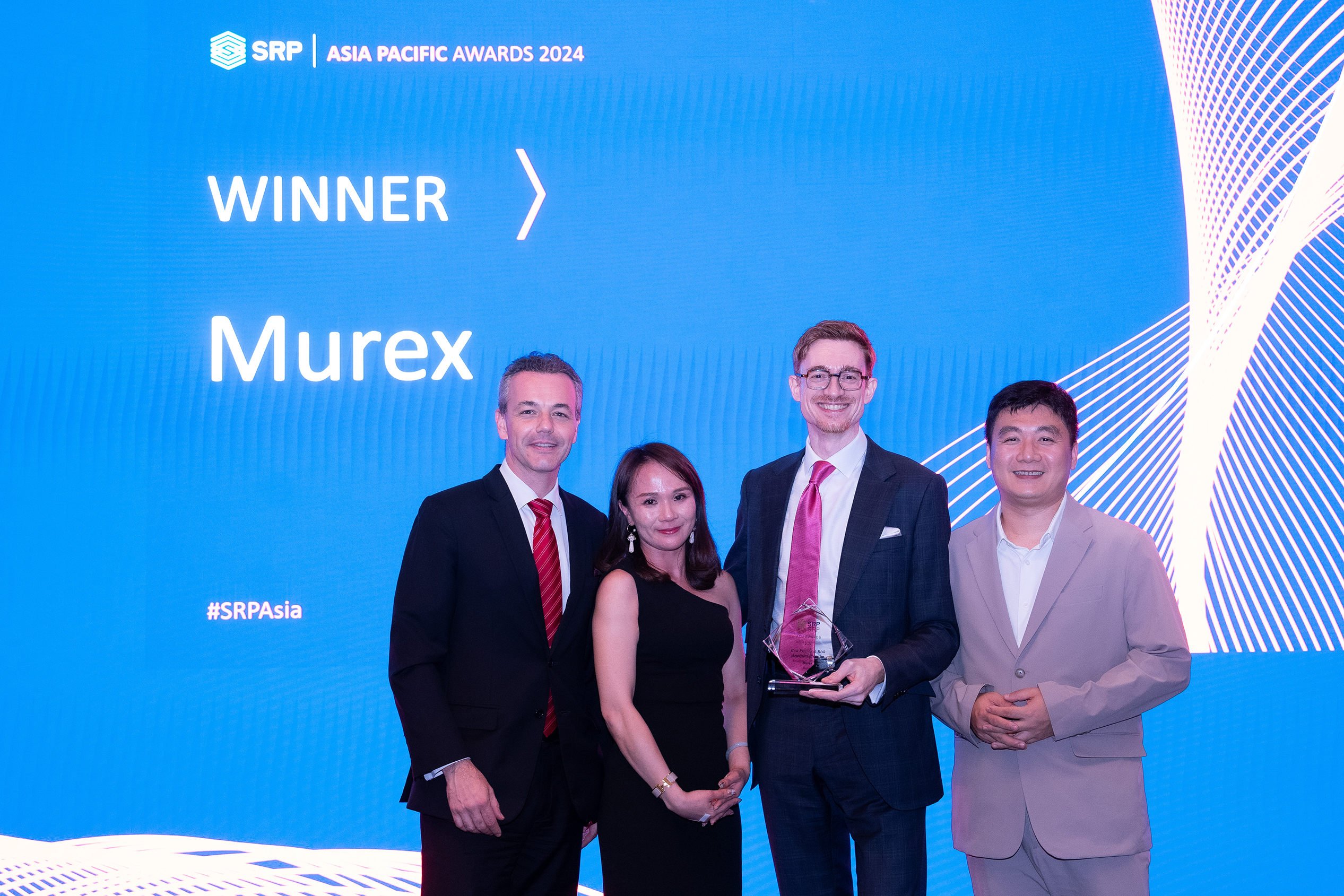-
Our solutions
- Our clients

With 300 clients and 60,000 users spread across 60 countries around the world, Murex has a truly international client base of capital markets participants.
view all case studies- Insights
- Who we are

Our awards highlight a strong level of customer satisfaction and acknowledge our market expertise.
Visit our awards webpage- Our partners
- Careers
SRP APAC 2024 awards: Murex - HSCEI autocall debacle has triggered a product shift
Murex won the Best Pricing & Risk Analytics Provider at this year's SRP Asia Pacific 2024 awards.
Written by Pablo Conde, SRP

The Paris-based financial services and tech provider was recognised as the Best Pricing & Risk Analytics provider in the Asia Pacific structured products market at the SRP Asia Pacific 2024 conference.
Looking back at last year's activity in the region, Alexandre Bon, head of marketing, presales & go-to-market, APAC, notes that the volume of activity related to structured products "was pretty much a continuation of the previous year".
"We saw increased activity in some markets like China, where banks continue to roll out more flavours of structured deposits with new pay-off variations as well as new underlyings," said Bon. "Some of the trends we saw in 2023 have got stronger this year, especially in the rates space."
Bon sees two reasons behind this trend - on one hand, "higher rates in some jurisdictions have triggered more demand for hedging products as well as for capital protected structures, especially on the retail side".
"The other factor is the fact that many currency markets have moved now to risk-free rates compounded overnight benchmarks which have a completely different dynamic as an underlying than what we used to have with Libor and requires the entire representation and back office dimensioned as well as the analytics," he added.
In terms of pricing and risk, the work has been "more complex, heavier".
"There has been a fair amount of optimisation and also a catalogue of repackaged payoffs especially for exotic structured products."
The drawdown of the Hang Seng index did not go unnoticed in 2023 and earlier this year as it triggered the knock-in features of a majority of the large volumes of autocallables held by retail customers in Korea, leading to significant capital losses.
"This has basically dried up completely the autocallables market, which has forced many of our clients to scramble in search of an alternative to one of their biggest money-making activities," said Matthieu Avanthey, head of product management, APAC.

"This has triggered a shift towards credit-linked and capital protected products mostly linked to interest rates and European underlyings."
In China, despite investors being "quite agnostic when it comes to underlyings", there was "a shift in activity towards FX as well as precious metals", said Avanthey.
According to Fanchao Zeng, structured products product manager for APAC, there is a noticeable trend on precious metal especially in China which was a market traditionally focused on autocalls on equity indexes such as the CSI 500 and CSI 300 indices.
"Nowadays, we have four banks in China that are implementing autocalls referenced to gold as an alternative to their equity-linked autocalls," said Zeng. "These banks are also exploring payoff variations such as call spreads and shark fin structures. This dynamic we observe among Chinese and Korean clients which are also trying different things like credit and FX."
What opportunities are driving growth for Murex in the APAC region?
Alex Bon: We are getting requests from product providers looking to centralise their systems to be able to run their activities in different regions using a certain common instance to basically benefit from efficiencies and minimise regional operational risks.
We are also working with smaller regional domestic institutions trying assets they did not cover before as well as others seeking to venture into new asset classes or do exotic payoffs on those asset classes.
We have received requests for things that were not needed before or to extend the scope of the product offering on the risk side. When volumes around a particular product type or asset class grow, product providers must be able to manage and scale that volume in terms of back-office integration and risk management.
With higher volumes, you also need to properly handle payments, confirmations, accounting, regulatory reporting – through a life cycle of complex trade events. Front-to-back automation is key to reduce operation costs and operational risk, and to reduce the time-to-market of new structures. These kinds of products require heavy calculations real-time portfolio risk management (e.g. intra-day digital risk for autocalls) or XVA pricing (X-Value Adjustment). One needs fast and accurate analytics that can scale efficiently. That's where there's a lot of work to do and where we offer a strong value proposition.
Beyond product development there are other topics mostly around banks refactoring and reorganising their infrastructure, and bringing together teams and functions that were geographically separated.
Matthieu Avanthey: Over the last two to three years a number of clients involved in structured products that started relatively small and not very sophisticated and were just redistributing products on a back-to-back basis, are now looking to build up and grow their ambitions.
We see a number of those clients gradually shifting to warehousing more risk, as well as splitting and managing the hedging themselves. This allows them to become more competitive and potentially price lower than their competitors since they do not have to pay a margin to a tier 1 bank.
This shift to warehousing obviously requires more sophisticated hedging tools, valuation and analytic capabilities on the risk side, as well as a much more solid technical infrastructure to absorb the new calculations workload. We see this trend in several markets like Malaysia, Thailand, India and China, and MX.3 is exactly the right solution for these issuers.
Fanchao Zeng: Throughout the Libor transition most clients had a wait and see attitude, but that has changed, and we now have quite a big pipeline of clients in Korea and Thailand looking to develop exotic rate products like range accruals on CMS spreads as well as callable reverse floater.
These products are being requested multiple times by different clients across Southeast Asia markets - Thailand, Malaysia and Singapore. Rate products are moving towards this kind of new index in quite a rapid way.
Can you talk us through a couple of recent use cases in the region that helped your clients to solve specific problems/challenges they faced?
Fanchao Zeng: With the rise in the demand for precious metals there is an interesting aspect around the physical delivery part which is always challenging for product providers. The pricing can be easy, but to cover the whole delivery can be complicated. We have a system solution called the 'bridge module', which covers a wide range of derivatives and naked structures out of the box. This tool allows you to deal with the physical delivery within our system.
Another recent use case involved our analytics on market data. One of Indian clients wanted to sell a reverse floater with a different frequency. Typically, in the Libor word, the frequency was set up at three months or six months, but they wanted to offer something to their corporate clients every four or nine months. To resolve this, we used our 'multi tenor/ multi framework solution', which can give you, even if you're going for the three months frequency, an arbitrage free accurate pricing.
A significant challenge was the valuation of floaters with non-standard tenors, which Murex quants addressed using a multi-tenor volatility framework. This framework leverages liquid source volatility to ensure consistent and precise caplet volatilities across different tenors, enabling our Indian clients to offer tailored collared floaters that meet market demands.
What is Murex's edge in the structured products market as a fintech and analytics provider?
Alex Bon: We have two key differentiators. One is the scope of asset class coverage that we have which very few if any vendor can replicate. On the risk side, our cross-asset model covers everything and that is very difficult to find in the market.
The other point is that we go beyond just the pricing and analytics. We embed the analytics in a platform that the client can use for pricing, structuring, risk management and middle office, as well as for P&L control, accounting and regulatory reporting.
Matthieu Avanthey: Our clients can run an entire activity front to back as well as risk management across all their desks on a single platform. With a growing number of institutions trying to engineer and rationalise their infrastructure our proposition is very solid. In terms of support model, we are also unique, as we offer a very strong specialist support base, and clients know that we are here to work with them with an efficient model to support the entire activity.
The key value from a product perspective is that we enable the risk warehousing, they are not limited in terms of volume, and our platform allows them to automate and industrialise the activity.
You might be interested in ...
- Our clients


